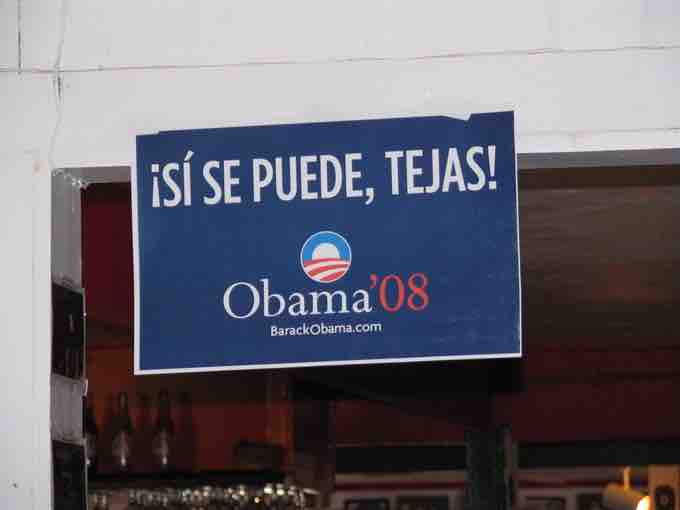Age and Political Participation
Political participation differs notably by age . People between the ages of 35 and 65 are the most politically active. At this stage in life, people are more likely than younger people to have established homes, hold steady jobs, and be settled into communities. Those with stable community roots often have strong incentives and greater resources for becoming involved in politics. Senior citizens, people age 65 and older, also have high turnout rates of around 70 percent.
Historically, young people have been less likely to vote as they often lack the money and time to participate. However, the youth vote has been on the rise: turnout among 18 to 24-year-olds was at 36 percent in 2000, but this rose to 47 percent in 2004 and 51 percent in 2008. This rise in youth vote is partly a result of voter registration and mobilization efforts by groups like Rock the Vote. An important factor in the increase of younger voters in 2008 was the greater appeal of a younger, non-white candidate in Barack Obama. According to the Pew Research Center, 66% of voters under 30 chose Obama in 2008. New technology, especially the internet, is also making it easier for candidates to reach the youth. Websites such as Facebook and YouTube not only allow students acquire information about the polls, but also allow them to share their excitement over the polls and candidates.
Gender and Political Participation
Political scientists and journalists often talk about the gender gap in participation, which assumes women lag behind men in their rates of political engagement . However, the gender gap is closing for some forms of participation, such as voting. Since 1986, women have exceeded the turnout rate for men in presidential elections; 66 percent of women cast a ballot in 2008 compared with 62 percent of men. This may be due to the political prominence of issues of importance to women, such as abortion, education, and child welfare.
Race, Ethnicity, and Voting: African Americans
Participation and voting differs among members of racial and ethnic groups . Discriminatory practices kept the turnout rate of African-Americans low until after the passage of the Voting Rights Act of 1965. Poll taxes, literacy tests, and intimidation kept black voters from the polls. Eventually, civil rights protests and litigation eliminated many barriers to voting. Today, black citizens vote at least as often as white citizens who share the same socioeconomic status. Collectively, African Americans are more involved in the American political process than other minority groups in the United States, indicated by the highest level of voter registration and participation in elections among these groups in 2004. Sixty-five percent of black voters turned out in the 2008 presidential election compared with 66 percent of white voters.
Race, Ethnicity and Voting: Latinos
The Latino population in the United States has grown to over 47 million people from diverse countries of origin. Although this group forms a substantial political bloc, only 49 percent of eligible Latino voters voted in the 2008 presidential election. Language is one barrier to Latino participation. Candidates recognize that Latinos constitute a large and growing voting bloc and have begun campaigning in Spanish. During the 2000 presidential election campaign, candidate George W. Bush ran nearly as many ads in Spanish as in English. The 2008 presidential candidates' websites, as well as the 2010 congressional candidates, featured extensive Spanish-language content .

Reaching the Latino Vote
Candidates routinely aim campaign ads at the fast-growing Latino and Asian American populations.
Race, Ethnicity, and Voting: Asian Americans and Pacific Islanders
According to the U.S. Census, Asian Americans and Pacific Islanders are the fastest growing and most diverse ethnic group, yet their rates of participation are lower than other groups. In 2008, 48 percent of Asian Americans turned out to vote. Some argue that cultural factors, such as a strong tie to their ethnic culture, contribute to the lower levels of Asian American and Pacific Islander voting. However, Asian Americans who have been victims of hate crimes or consider themselves to be part of a deprived group find their way to the polls in greater numbers.
Religious Convictions and Voting
Oftentimes, religious convictions motivate voters. The most prominent example of this in American politics is the Christian right, which consists of right-wing Christian political groups that are characterized by their strong support of socially conservative policies. In the U.S., the Christian right is an informal coalition formed around a core of white evangelical Protestants that draws support from other groups who share their goals. Voters who are part of the Christian right hold socially conservative positions on issues including school prayer, stem cell research, homosexuality, contraception, abortion, and pornography. About 15% of the electorate in the United States supports the Christian right. Much of the Christian right's power within the American political system is attributed to their extraordinary turnout rate at the polls. The voters that identify with the Christian right are highly motivated and driven to deliver a viewpoint on issues they care about.